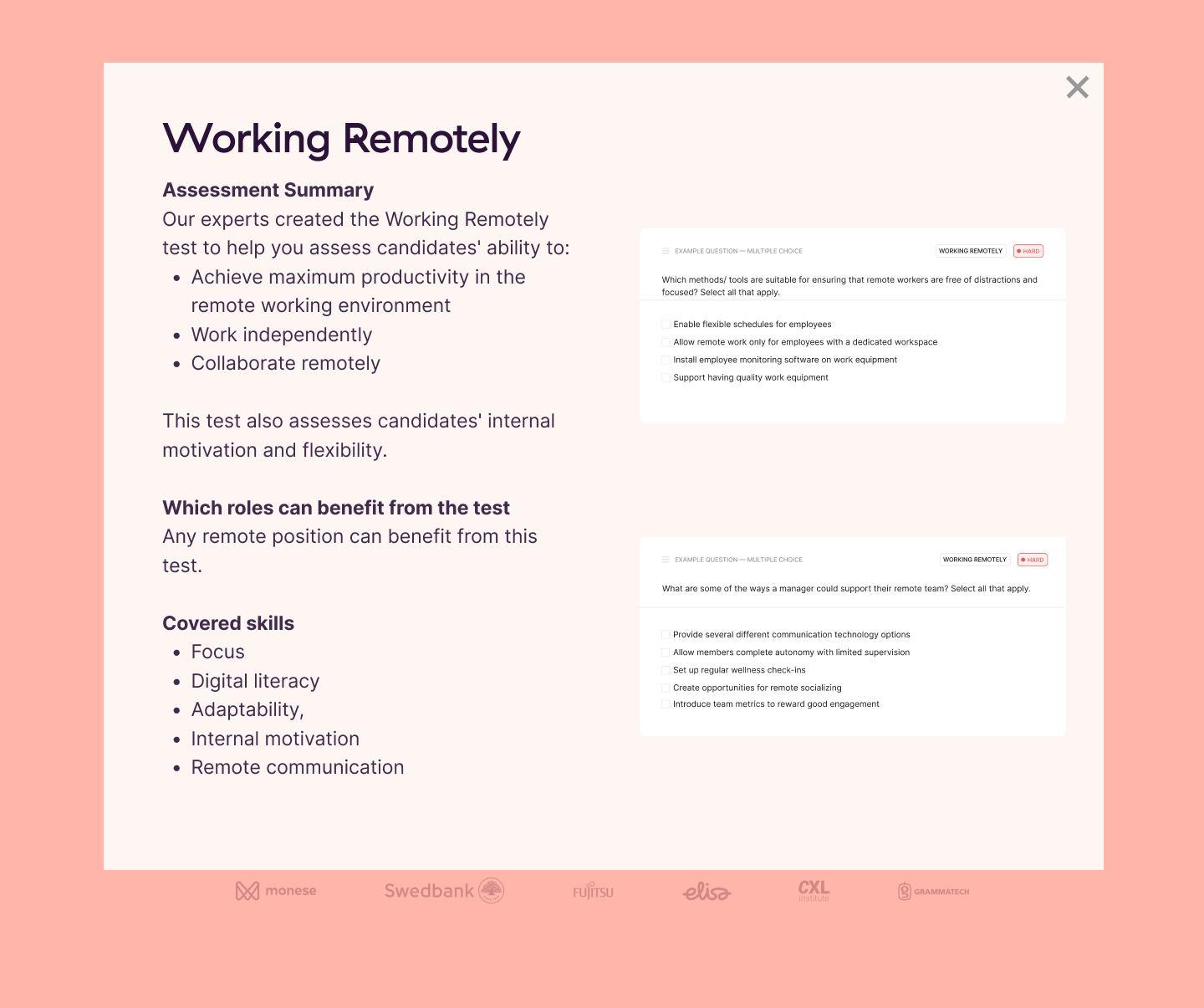82% of people believe that remote work is the future, and in 2024, 56% of global companies allow remote work, while 16% of global companies are fully remote. Recruiters haven’t quite caught up, though, with many making simple remote hiring mistakes that destroy their talent pipeline. 💣
If you’re still getting started on your remote hiring journey, this guide will point you in the right direction. We’ll run through nine simple mistakes most hiring managers make (and how to fix each one) when hiring remotely.
Mistake #1: Relying on CVs to pre-screen candidates
The correct remote hiring method: Use more modern remote hiring methods.
There aren’t many industries that move faster than recruitment, so it’s baffling to us that many modern organizations still rely so heavily on CVs. Resumes are one of the worst ways to screen candidates because:
- They prove nothing. A great CV only proves that your candidate is good at writing a CV. It doesn’t provide a real-life, performance-related view of how good someone is at their role.

- They’re admin-heavy. With many roles attracting hundreds of applicants, they’re an absolute time-killer to review, sift, and assess, often taking up hours of valuable recruiter time.
- They’re boring. CVs aren’t fun for anyone. For candidates, they’re the least engaging way to apply for a role, and for recruiters, they’re all the same and take ages to read.
When you bring these factors together, it makes the hiring process slow, uninclusive, flawed and delivers a poor candidate experience. As we’ll come on to later, there are several great ways to pre-screen candidates that don’t include resumes; that’s why it’s one of our key mistakes to avoid.
Mistake #2: Using the interview process to suss out successful candidates
The correct remote hiring method: Use performance-based pre-employment tests to identify the best remote workers.
When hiring remote workers, many employers over-rely on the interview process to identify the best remote candidates for the job. That’s a mistake for two key reasons:
- Firstly, some of the best candidates may be amazing at their job but not very good at interviewing. Interviews are simply the wrong format to assess candidates unless your roles are based exclusively on soft skills.
- Secondly, the reverse is also true. Some candidates are amazing at interviewing and may trick you into thinking they’re more qualified than they actually are. This leaves you at risk of making a bad hire and bringing on board a new employee who simply can’t do the job.
That’s why we always recommend focusing on competency skills assessments and skills tests when hiring to ensure that remote workers can actually do the job.

Mistake #3: Not communicating the recruitment process in the job posting
The correct remote hiring method: Make the hiring process steps clear for all remote candidates.
Another common mistake remote companies make is failing to clearly communicate how they run their hiring process. When a candidate lands on your ad on the job boards, they want to know that your way of working fits into the ethos of hiring remotely.
If they don’t, there’s a good chance they’ll be instantly turned off, assuming that you’ll expect an in-person interview to seal the deal.
Also, the hiring process is a two-way street. Candidates are flooded with career options, so they want to know the level of commitment they’ll need to put into your remote hiring process. If you don’t show you’re a remote-friendly organization, they’ll simply click on the next job ad and put the effort in elsewhere.
Mistake #4: Not assessing candidates’ ability to work remotely
The correct remote hiring method: Assess a candidate’s ability to work remotely alongside their core role.
Remote work is completely different from traditional office work. Not only do remote employees possess a completely different mindset to work, but there’s also a range of technical and non-technical skills they’ll need to master to be productive.
One of the common hiring mistakes new remote employers make is focusing only on the role at hand. Whether it’s managing a different time zone, using online communication techniques, or mastering new collaboration tools, remote hiring teams need to diversify their assessment criteria.

If you don’t, you might hire some amazing remote employees but find yourself stuck when in 3-6 months, they leave, as they can’t adapt to the day-to-day of remote work.
Mistake #5: Hiring remotely because you think it’s cheaper
The correct remote hiring method: Hire remotely to snap up the best talent and align with the ethos of remote work.
Let’s get this out the way right now; we know that hiring remote employees is cheaper than traditional recruitment methods. From a hiring perspective, it saves costs in travel, venue hire, and accommodation. But that’s not the only benefit.
Others include a boost in productivity, better work/life balance, and access to a wider talent pool. Of course, in an ideal world, your recruitment process should align with your general stance on remote working to set clear expectations for your future employees.
If the only benefit you’re currently receiving from hiring remotely is saving cash, you’re probably doing it wrong!
Mistake #6: Not discussing working hours, communication etiquette, and general expectations
The correct remote hiring method: Setting clear expectations about the business from the start.
To avoid this mistake, be transparent during the interview process and explicitly define what remote work means for your organization.
Whether the working hours align with the candidate’s time zone, the company policy on communication tools, the onboarding milestones, or simply the working hours, you need to give future employees all the information upfront.
Fail to do so, and you risk employees making a fast exit from your company when they realize working remotely isn’t right for them.
Mistake #7: Not using hiring tools designed to hire remote workers
The correct remote hiring method: Use a tool tailored to hire those working remotely.
One of the common mistakes companies make when transitioning to remote hiring is not updating the systems they use for their hiring process. No one system can do everything, so make sure you transition to a remote work specialist.
As we saw earlier on, there are so many amazing ways to turbocharge your recruitment process, including dropping traditional methods, such as resume sifting, in favor of skills tests or other types of job simulations.

At Toggl Hire, we’ve got remote skills testing down to fine art. After all, we’re a fully remote company, with staff based all over the world working to create the greatest skills testing tool on the planet. Plus, we purpose-built Toggl Hire to serve specific remote hiring needs.
Toggl Hire helps you revolutionize your recruitment process, allowing you to assess candidates on the skills that really matter for your role. It’s quick and easy to set up, fun and engaging for candidates, and a great way to deliver data-driven applicant tracking at scale for your organization.
If you like the sound of that, check out our 1-minute explainer video below. 👇
Mistake #8: Not taking measures to eliminate unconscious bias
The correct remote hiring method: Adjusting hiring practices to create a fair and inclusive process.
One of the most crucial things to avoid when hiring is accidentally including bias in your recruitment process. Not only is it completely unfair to candidates, but if you let bias creep into your process, you’re inadvertently shooting yourself in the foot when it comes to landing the best talent.

One of the biggest ways to avoid these mistakes is to pivot to an objective, performance-based hiring process, where candidates are assessed purely on their skills and competencies rather than subjectively on personal characteristics, education, or previous experience.
You can read more about the Types of Unconscious Bias and how to create Fair Chance Hiring Practices on the Toggl Hire Blog.
Mistake #9: Not having a solid onboarding process for remote employees
The correct remote hiring method: Adjust how you onboard to help remote employees.
Our last common mistake centers around employee onboarding. One area that business leaders always get wrong is assuming the remote work changes once the new employee has accepted the job offer.
In reality, the onboarding process is critical for remote workers, as it’s their first chance to meet team members, adjust to the remote culture, and get to know the company’s communication and collaboration tools.
Working remotely can be isolating, so it’s essential to adjust the onboarding process for remote workers to help them feel welcome and avoid leaving soon after joining the team.
Avoid the most common remote hiring mistakes
When transitioning to remote working models, it’s important that your recruitment process doesn’t get left behind. Everything from posting on job boards to managing onboarding needs to be re-considered to ensure the candidate experience is as smooth as possible when employees land and start their new jobs.
But, if you overcome these nine most common mistakes, you and your business will be in a great position to seek out new remote employees and reap the benefits of remote hiring for years to come!
After you’ve built a solid remote team, learn how to manage remote workers effectively to boost productivity, employee engagement, and other key business metrics. 👇
Juste loves investigating through writing. A copywriter by trade, she spent the last ten years in startups, telling stories and building marketing teams. She works at Toggl Hire and writes about how businesses can recruit really great people.




